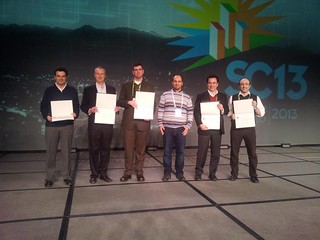 |
| Part of the winning team accepting the 2013 Gordon Bell Prize. |
Why bubbles? It turns out that when bubbles burst or cavitate, in scientific parlance, they can be very destructive, causing tremendous damage. Look closely at a motor boat propeller and you may see thousands of dimples on the metal caused by bubble cavitation.
But scientists at ETH Zurich, the renowned Swiss university, and IBM Research, in collaboration with the Technical University of Munich and the Lawrence Livermore National Laboratory (LLNL), have bigger ideas than just improving industrial technology. When harnessed, these violent bubbles can also shatter kidney stones and destroy tumorous cancer cells.
It’s all part of the field of fluid dynamics but, due to the short time scales involved with moving liquids, its quantitative understanding has been elusive for experimentalists and computational scientists.
That was until scientists at ETH and IBM were given the challenge to simulate cloud cavitation collapse (the simultaneous bursting of thousands of bubbles) and granted access to one of the fastest supercomputers in the world, the IBM Blue Gene/Q “Sequoia” at LLNL.
 |
| 15,000 bubbles simulated in a new record. |
“We were able to accomplish this using an array of pioneering hardware and software features within the IBM Blue Gene/Q platform that allowed the fast development of ultra-scalable code, which achieves one order of magnitude better performance than the previous state of the art,” said Alessandro Curioni, head of the Mathematical and Computational Sciences department at IBM Research - Zurich.
Petros Koumoutsakos, director of the Computational Science and Engineering Laboratory at ETH Zurich, who led this project, adds, “We have based our developments on finite-volume methods, perhaps the best established and most widespread method for engineering flow simulations. We have also invested significant effort in designing software that takes advantage of today’s parallel computer architectures. It is the proper integration of computer science and numerical mathematics that enables such advances.”
The scientists hope the attention attracted by the award will open up new opportunities to collaborate with medical doctors to further explore the applications of bubble cavitation in healthcare.
Follow the two IBM Gordon Bell prize winners on Twitter: Alesssandro Curioni @Ale_Curioni and Costas Bekas @CostasBekas

Dear Sir:
ReplyDeleteI am Annie Wei, from National Center for High-performance Computing and Networking (NCHC, Taiwan). We would like to introduce the 2013 SC's ACM Gordon Bell Prize in our e-newsletter (in Chinese and English). It will be the "Technology Perspective" section . This section shares international Technology news. Is it possible for us to use the bubbles research photo ( this one:http://farm8.staticflickr.com/7375/10836561673_574848155b_n.jpg) . We won't cut the logo and we will show the resource. Thanks for your kindly reply in advance.
Contact email: annie@narlabs.org.tw
NCHC's e-newsletter: http://www.nchc.org.tw/en/e_paper/index.php?EPAPER_ID=83
Hi, yes you have permission. I will email you directly.
Delete